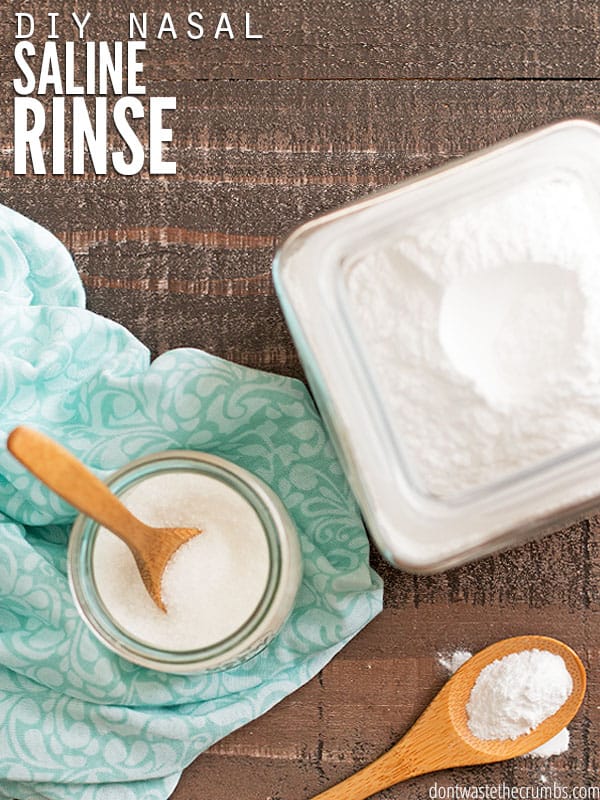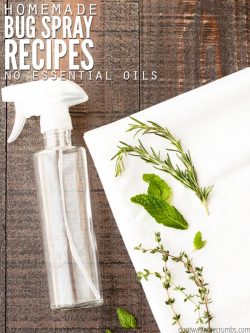Easy recipe for a nasal saline solution with 3 simple ingredients. Learn how to use homemade nasal decongestant, plus tips for using saline for allergies. This is one of my go-to home remedies, like homemade elderberry syrup and whipped magnesium lotion.

Spring has sprung here on the East Coast. The trees are all bright green, flowers are in bloom, and the air is warming up.
There’s also a yellow dusting of pollen over everything and my allergies are feeling it!
Along with healing swimmer’s ear naturally, I have a few tricks that help me manage my allergies naturally too. One of those is making my own nasal saline rinse, which is super easy and saves money in the long run!
Nasal Saline Solution: What does it do for your nose?
Nasal saline solution can do a lot for your nose/sinuses. Here are a few known benefits of using a saline solution:
- Cleans out your nose from allergens and bacteria.
- Moisturizes your nasal passages (they can become dry if you blow your nose a lot).
- Thins mucous membranes.
- Helps stop runny noses.
And it is super easy to make! With a few ingredients and a little bit of time, you can have your nasal saline solution ready for you all year long (or however long your particular allergy season happens to be.) Plus it is much cheaper than buying it at the drug store.
Nasal Saline Rinse Recipe
If your doctor has given medical advice to use saline irrigation for your nose, they may have mentioned you can also make it at home.
This recipe was given to me by a doctor, and it’s the same recipe I’ve been using ever since.
- Canning salt (no exceptions!)
- Baking Soda
- Distilled Water (alternatively you can boil water and then allow it to cool)
How to Make Nasal Decongestant at Home
Here are the simple steps to make a nasal saline solution at home:
- In a glass jar mix together: 2 cups canning salt and 1/4 cup baking soda
- Mix together, seal well, and store in a dry, cool place.
How to Use Homemade Nasal Saline Solution
Each time you use your nasal rinse, fill your rinse bottle with 8 ounces of distilled water and add 1 teaspoon of solution. Shake together. And use as directed per your nasal rinse bottle instructions.
Note: I’m re-using a bottle I originally bought with a kit. If you don’t have one, combine the water and solution in a jar and use a nasal aspirator to rinse. You can also look into other methods like the neti pot, nasal bulb syringe, squeeze bottle, etc. Just follow the instructions.
An additional tip for doing the nasal wash: I find it best to heat up the solution first. This shocks your nose a bit less and is much more soothing. You can heat up the solution in the following ways:
- Boil 8 ounces of tap water and once it has cooled to lukewarm, go ahead and do the rinse then.
- Microwave the distilled water for 10 seconds first.
- Prepare the solution in a nasal rinse bottle and place it in a larger jar. Pour hot water in the jar and allow the solution to warm up slowly. (Like you would a baby bottle.)

Fight Inflation Workshop
Sign up for my FREE Fight Inflation Workshop and learn simple strategies to save money, even with rising food costs!
Can you use table salt for a nasal rinse?
Simply put: no. This recipe strictly calls for canning salt (no exceptions!).
You’ll get the best deal on canning salt when you buy it in bulk, and this is the best deal I found online. You can find canning salt at most stores locally, although agriculture stores tend to have a better deal for buying in bulk. The best deal on baking soda will be at big box stores like Costco, Sam’s Club or BJ’s.
Saline Rinse for Allergies
For me, rinsing my nose with saline solution has by far been the most effective solution for my allergies! Every morning and evening, I use a nasal saline rinse bottle to rid my nose of all the pollen, dust, and dirt it has collected throughout the day.
It has helped more than any allergy medication ever has. I hope that this can help you find some relief and go out and enjoy the flowers!
Additional Tips for Managing Seasonal Allergies
- Shower at the end of the day. When the pollen count is high it is best to shower at the end of the day, so you are not sleeping with a head covered in the stuff that makes your eyes water!
- Use local honey as a sweetener. I believe it has helped me and my family build our immunity to local allergens so I choose to buy local in case there is any proof that it helps with allergies (plus I love to support local farmers!).
- Keep your windows closed in the spring months. It is tempting to open up the windows to let the cool spring breezes in, but if you are a severe allergy sufferer, you are just letting the enemy invade your home!
- Irrigate your nose with saline solution at least once a day.






So the iodine is why my nose stung when I tried making my own nasal irrigation solution! Good to know. I’ve found non-iodized salt at my local grocery. I may try that if I can’t find canning salt easily.
I am wondering the same about canning salt?
Because canning/pickling salt doesn’t contain iodine, which can be irritating and sting the nose. Hope that helps…:)
Why canning salt and not sea salt or Himalayan salt? Just wondering!